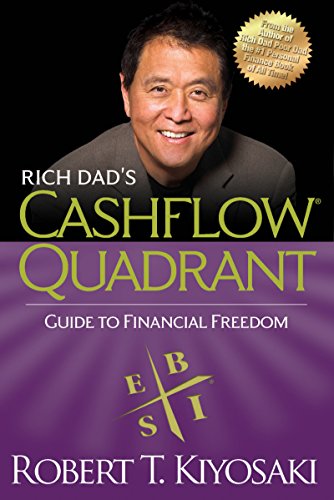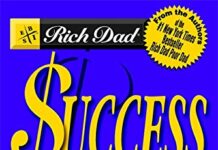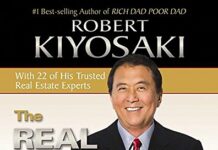
Ebook Info
- Published: 2015
- Number of pages: 320 pages
- Format: PDF
- File Size: 8.99 MB
- Authors: Robert T. Kiyosaki
Description
Rich Dad’s CASHFLOW Quadrant is a guide to financial freedom. It’s the second book in the Rich Dad Series and reveals how some people work less, earn more, pay less in taxes, and learn to become financially free.CASHFLOW Quadrant was written for those who are ready to move beyond job security and enter the world of financial freedom. It’s for those who want to make significant changes in their lives and take control of their financial future.Robert believes that the reason most people struggle financially is because they’ve been spent years in school but were never been taught about money. Robert’s rich dad taught him that this lack of financial education is why so many people work so hard all their lives for money… instead of learning how to make money work for them.This book will change the way you think about jobs, careers, and owning your own business and inspire you to learn the rules of money that the rich use to build and grow their wealth.
User’s Reviews
Reviews from Amazon users which were colected at the time this book was published on the website:
⭐I read Rich Dad, Poor Dad many years ago, and frankly I didn’t think much of it. The core idea is imperative to understand – poor people buy liabilities, rich people buy assets. A critical idea, but it seemed like the book was just a bunch of fluff other than hammering that one concept (though again, an important one). And i didn’t think much more about Robert and his work until I read Cashflow Quadrant.Interestingly, Robert apparently is somewhat of a controversial figure. When I mention his name, people either seem to love him, or think he’s a scam and a liar. I can’t comment too much on that, other than to say, from what I have seen in his videos and books, he seems to be a very genuine and honest person with intent to help people.Either way, it’s irrelevant. Cashflow Quadrant os a fantastic book that almost anyone should read IMO. I’m only halfway through and I’ve learned so much already. I’ve never seen this good of a perspective and practical advice on the mindset you need to evolve from an employee or self-employed to a business owner or investor.It explains the specifics of each, and how you actually need to become a different person to succeed in each, and what those mindsets are. I found myself firmly in the Self-Employed mindset, and when he explained that profile in 1-2 pages, I never felt so personally profiled. It really opened my eyes to where I’ve been stuck.Anyway, great book so far and I highly recommend it. I ended up buying the bird game as well, and it’s also one of the best tools to teach children financial intelligence, and all the things we sadly aren’t taught in school.
⭐Great book. I highly recommend this of material to everyone who wants to become an entrepreneur and move quickly from rat race to financial freedom….Robert is one of the best.
⭐Love the details of this , makes sense.
⭐Read this book over and over till I get the ideas hammered in. I suggest you do too. Like I said good read
⭐Rich Dad’s Cashflow Quadrant is the sequel to Rich Dad, Poor Dad by Robert Kiyosaki. I was skeptical at first, but I ignored the negative reviews and got a copy, and I don’t regret it. Once I started reading, I couldn’t put it down.Kiyosaki follows his previous book by continuing to emphasize the importance of a “different kind of education” that is founded on an understanding of money. He introduces the Cashflow Quadrant, which, as the name indicates, has four sections: Employees, Self-employees, Business Owners, and Investors. Each quadrant has advantages and disadvantages, and as the author explained, they’re not created equally. It’s crucial to understand each quadrant’s strengths and weaknesses before making a change if you want to maximize your odds of success. Each quadrant has its unique language and requires a specific set of skills to thrive in that role.We have all heard the saying, “The rich get richer and the poor get poorer.” Most people don’t understand why and how this works. It’s not merely because the rich are rich: they use money differently than the majority. The rich do not work for money to spend it on liabilities. Instead, they invest it on assets that’ll make more money, and as a result, their wealth multiplies. The poor and the middle class, on the other hand, work for a limited income which they spend on liabilities like mortgages, cars, loans, credit cards, and consumer electronics. They often avoid investing because “it’s too risky,” but as the author wrote, and I agree, it’s riskier not to invest.Anyone can achieve financial success and freedom by increasing their financial IQ and reforming their view of money. A great start is reading Rich Dad, Poor Dad. The majority of us believe that the solution to our financial problems is a raise in salary or winning the lottery, but as Rich Dad often says, “More money will not solve the problem if cash-flow management is the problem.” Debt has become the norm for the U.S. population, and not the right kind of debt that can be used to make a profit, but the kind that keeps you in the rat race.What I enjoyed most about this book that I found lacking in its predecessor, were the Rich Dad teachings. You’ll notice more references and lessons from Rich Dad than in the previous book. This book is pure one-on-one financial mentoring.I do disagree with Kiyosaki on one topic: frugality. Kiyosaki doesn’t believe in frugality. Instead, he believes that “expanding your means” is a better strategy because it forces you to find ways of making more money. Although expanding your means is a good strategy, combining it with frugality would amplify your wealth accumulation faster.Overall, I recommend this book to anyone who wants to not only improve their financial situation but change the way they think about money.
⭐Helpful financial tidbits
⭐This book will pound a business perspective into your head. That’s good if you need to switch your thinking from one of being an employee to one of being an economic pirate (as Bucky might say).Kiyosaki also gives some critical tips and a book list to continue learning how to read the marketplace.
⭐Very informational and mind transforming. My whole mindset has now shifted and I’m now very ready to make that move from the left side of the quadrant to the right.
⭐The concept of the Cashflow Quadrant and the emotions, behaviours, AND values of people in each quadrant is the biggest lesson here. It is good to have this information at a very young age so you can guide your decisions with the wisdom of this book. I recommend this to everyone but i think this will be extremely useful for anyone coming out of college so they can choose a career path and a lifestyle with eyes wide open.Rich Dad, Poor Dad is also excellent but I have always found this a more powerful book. Read both.
⭐So I finally arrived at the cash flow quadrant. Thank you Mr Kiyosaki for imparting you knowledge, Wisdom and understanding of the financial world. One of the questions I’ve been asking – why do the Rich gets richer? Has been thoroughly answered in more ways than one and I have acquired useful tools, Wisdom and knowledge that will help me to modify my actions. I’m already en route to the B and I quadrant and this book has been an excellent guide and mentor. Thank you again and God bless you sir.
⭐I’m only 1/4 of the way in and Robert Kiyosaki has already blown my mind with the amount of golden information in this book.I would say that this is an even better book and I’ve been learning far more information than his best-selling book Rich Dad Poor Dad.Definitely get this book, it’s helping me shift my thinking considerably by walking me through the different quadrants and some hilariously accurate descriptions of where I am right now.This book is helping me shift my thinking from the S quadrant into the B and the I quadrants. I would definitely recommend this for anyone trying to do the same.
⭐You need to read this book! It is not the best read, not the most enticing and you should read Rich dad poor dad first. You will not gain a world of knowledge from this book either but you will reinforce basic knowledge and gain a fresh and encouraging view on your personal finance situation after reading it. You will also view your employment from another perspective and probably start mentally simulating a path through the quadrants. My advice, read it after Rich dad poor dad, read it fast preferably in a couple of days and understand it. Make parallels between the book and your own life, start thinking differently, get a piece of paper and a pen and ink out possibilities and paths you could take with the ideas from this book.
⭐This book is a nice reminder of the importance of being financially literate. You will certainly not become an expert in the fields of finance and investment just by reading this but at least you might realise you know even less than you thought. That feeling was enough for me to commit to educate myself. I really recommend this book.Tevin Gongo
Keywords
Free Download Rich Dad’s CASHFLOW Quadrant: Rich Dad’s Guide to Financial Freedom in PDF format
Rich Dad’s CASHFLOW Quadrant: Rich Dad’s Guide to Financial Freedom PDF Free Download
Download Rich Dad’s CASHFLOW Quadrant: Rich Dad’s Guide to Financial Freedom 2015 PDF Free
Rich Dad’s CASHFLOW Quadrant: Rich Dad’s Guide to Financial Freedom 2015 PDF Free Download
Download Rich Dad’s CASHFLOW Quadrant: Rich Dad’s Guide to Financial Freedom PDF
Free Download Ebook Rich Dad’s CASHFLOW Quadrant: Rich Dad’s Guide to Financial Freedom

